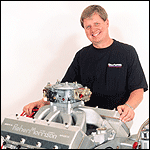 By David Reher, Reher-Morrison Racing Engines
By David Reher, Reher-Morrison Racing Engines
“Why does an engine with standard parts run better than one with all of the latest tricks, gizmos and gadgets?”
Sometimes technology can go too far. I recently purchased a cell phone that came with an instruction manual as thick as a brick. I use a telephone for one reason: to make calls. I didn’t buy a cell phone to play video games, take fuzzy photographs, download disco music, get directions to my house or monitor the stock market.
I know how to punch in a phone number, so I threw away the manual. I do not regret for a second that I am using only one percent of the capabilities of this technological marvel.
Sometimes racing engines turn into the four-stroke equivalents of cell phones. Racers who are dazzled by the latest gadgets, tricks and technology can lose sight of the basics. The purpose of a racing engine is to produce maximum power efficiently and reliably within the limits of the rules. Period.
An engine is an induction system, cylinder heads, a short block and a valvetrain. It doesn’t matter whether the engine competes in Formula One, Indy cars, NASCAR, or drag racing. If I’m talking to an engine builder in another form of racing, those are the parts that we talk about. All of the high-tech electronics, exotic materials and expensive trinkets are meaningless if an engine isn’t built on a solid foundation.
There are certain fundamental truths about racing engines. The first is that the cylinders must be sealed. That seems simple, but it is difficult to achieve. Engine simulation programs that boldly predict a certain level of performance assume that the cylinders are properly sealed, but that is sometimes an unwarranted assumption. It’s much more important to optimize cylinder sealing than to worry about 10 cfm of airflow.
A cylinder hone may not seem very sophisticated compared to a computer-controlled flow bench or dynamometer, but it is an essential tool of engine building. It takes years of experience and decades of data to learn how to hone for maximum power. Savvy engine builders have information on block hardness that extends back to the days of production castings. They know the different honing techniques that are required for grey iron, compacted graphite and ductile alloys. They recognize that ring material and profile make a huge difference when honing.
Oil ring tension does not necessarily determine whether a racing engine has powder-dry exhaust ports or black, oily ports. A dry engine is the result of honing the cylinders correctly and selecting the best ring package for the application. Of course, ring tension can be increased to the point that it will cover up an incorrect hone, but the motor will barely turn over, and it certainly won’t make good power.
The quality of the pistons is also crucial to cylinder sealing. I scrutinize ring grooves carefully because I know that not all pistons are created equal. Machining a first-rate piston begins with the blueprint; are the ring grooves located properly so that the lands are thick enough to support the rings? I’ve seen too many “trick” pistons with the ring package squeezed into a narrow space that’s dictated by the piston pin height. If the land under the top ring deflects and breaks the cylinder seal, then the engine simply can’t perform to its potential.
Exotic lubricants and expensive coatings are a waste of money if the short block clearances aren’t right. When the bearing and piston clearances are wrong, the parts are going to fail. Before spending big money on costly treatments, invest in a good set of micrometers and make sure that the clearances are correct.
The most important characteristic in a cylinder head is the ratio of the throat size to the valve size. That’s never mentioned in ads and articles that focus on flow numbers, and it’s not even considered in engine simulation programs. The fact that a port moves a certain amount of dry air in a steady-state flow bench test has only a tenuous connection to real world operating conditions. In a running engine, the flow is constantly in a dynamic state as the valves open and close and the piston rises and falls. The fact that a port flows X cfm at a predetermined depression has little relevance; the true test is whether the port develops a signal quickly in real time as engine rpm increases. And that can’t be measured on any flow bench.
A software program may calculate that an engine needs bigger valves, and the flow bench might confirm that larger valves indeed produce more airflow – but the engine may not care. In fact, it might not even accelerate as well as it did with small valves. Why? Because stuffing bigger valves into a cylinder can pinch off the airflow between the valve heads and the cylinder walls. The valve sizes must be in proportion to the bore diameter. Increasing the diameter of the valve 10 percent to pick up a 5 percent increase in airflow is never a good bargain.
Why does an engine with standard parts run better than one with all of the latest tricks, gizmos and gadgets? It’s usually because the builder took care of the basics with good cylinder seal, correct clearances, and a properly matched induction system. If you want technology for technology’s sake, my advice is to buy a cell phone.
